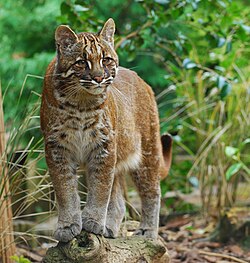Asiatisk guldkat
| Asiatisk guldkat | |
|---|---|
 | |
| Bevaringsstatus | |
 Næsten truet (IUCN 3.1)[1] | |
| Videnskabelig klassifikation | |
| Rige | Animalia (Dyr) |
| Række | Chordata (Chordater) |
| Klasse | Mammalia (Pattedyr) |
| Orden | Carnivora (Rovdyr) |
| Familie | Felidae (Katte) |
| Slægt | Catopuma |
| Art | C. temminckii |
| Videnskabeligt artsnavn | |
| Catopuma temminckii (Vigors & Horsfield, 1827) | |
| Hjælp til læsning af taksobokse | |
Den asiatiske guldkat (latin: Catopuma temminckii), eller Temmincks kat, er et kattedyr, som lever i Sydøstasien. Den ligner den afrikanske guldkat, men er ikke tæt beslægtet med den.
Taksonomi
Temmincks kat har været henført til slægten Pardofelis ligesom marmorkatten, men en specialistgruppe under IUCN mener stadig, at den bør henføres til slægten Catopuma sammen med Borneo-kat.[1]
Temmincks kat har navn efter den hollandske zoolog Coenraad Jacob Temminck, der som den første beskrev den afrikanske guldkat i 1827.
Kilder og eksterne henvisninger
- ^ a b McCarthy, J., et al. 2015. Catopuma temminckii. The IUCN Red List of Threatened Species 2015
| Spire Denne artikel om dyr er en spire som bør udbygges. Du er velkommen til at hjælpe Wikipedia ved at udvide den. |
Medier brugt på denne side
a black paw
Forfatter/Opretter: Karen Stout, Licens: CC BY-SA 2.0
The Asian golden cat is a medium-sized wild cat, typically weighing about 25 – 35 lbs. Its average length is about 4 feet including its tail. The Asian golden cat ranges from the lowlands of Southeast Asia up into the Himalayas, sometimes up to 3,000 metres. Its range includes parts of Bangladesh, Cambodia, India, Indonesia, Malaysia, Myanmar, Nepal, Thailand, and Viet Nam.
The beautiful coat of the Asian golden cat ranges from a dark orangey red to a golden brown, and is thick and coarse. Depending on the geographical location, Asian golden cats may have light spots on the underside; in China, they have darker rosettes all over the coat, similar to those of the leopard cat.
Asian golden cats are mainly nocturnal although sometimes they appear during the day as well. They are opportunistic predators, eating ground birds, rodents, reptiles, and other small-to-medium prey.
The Asian golden cat is listed by the International Union for Conservation of Nature and Natural Resources (IUCN) as Near Threatened. Threats to the Asian golden cat include habitat loss due to deforestation, indiscriminate snaring, and illegal trade in its pelt and bones. In Southeast Asia, it is also threatened by falling numbers of prey animalsForfatter/Opretter:
- Status_iucn3.1_NT.svg: Peter Halasz
- derivative work: Jeffrey Lins
Danish version of system image for conservation status


